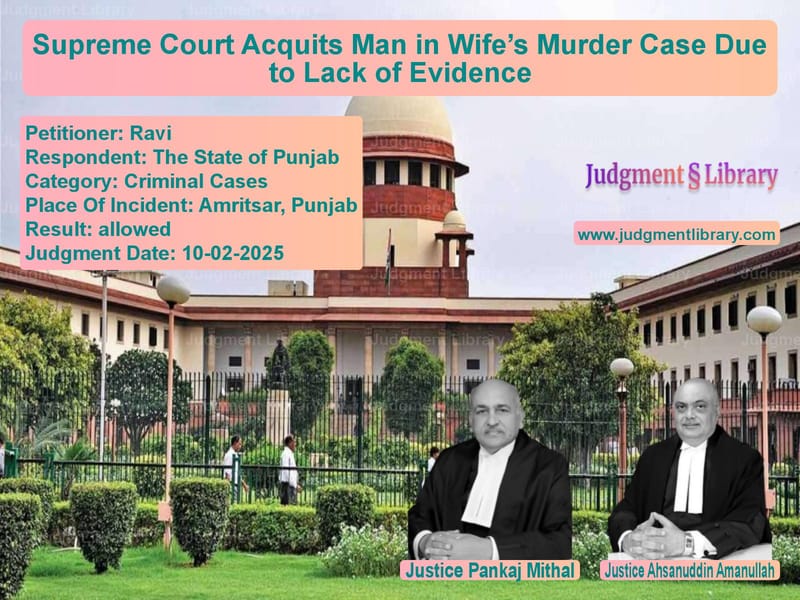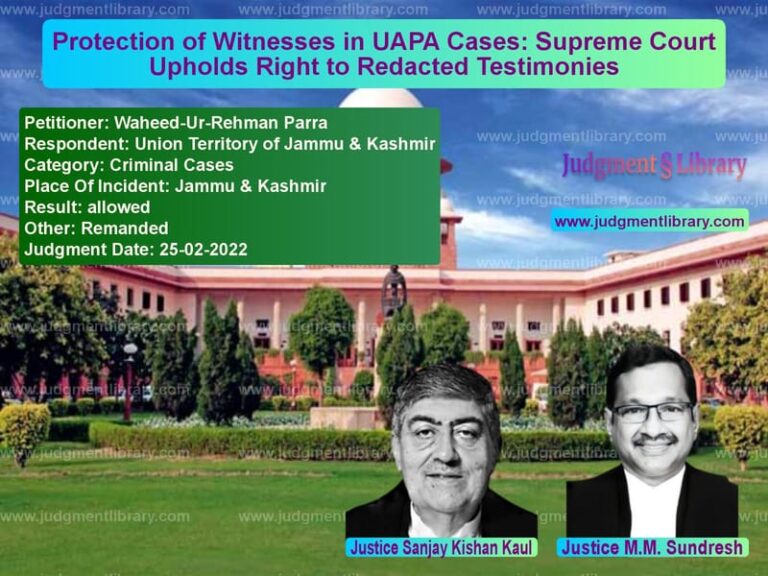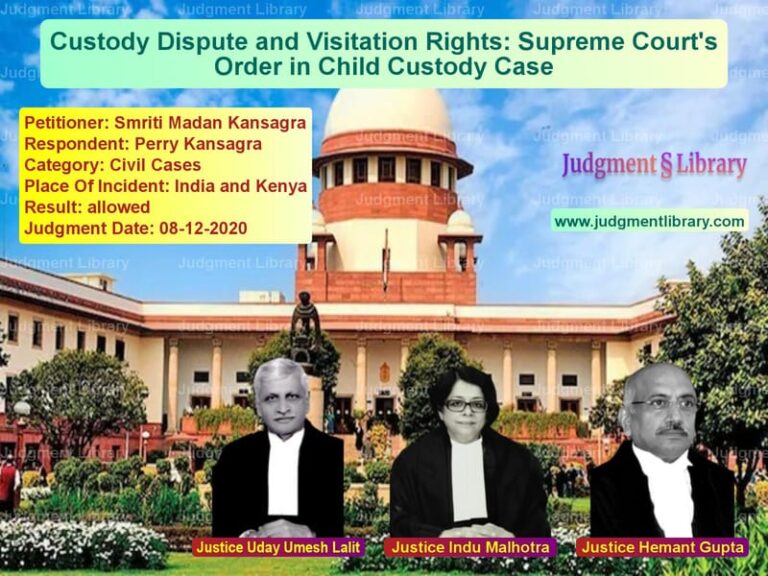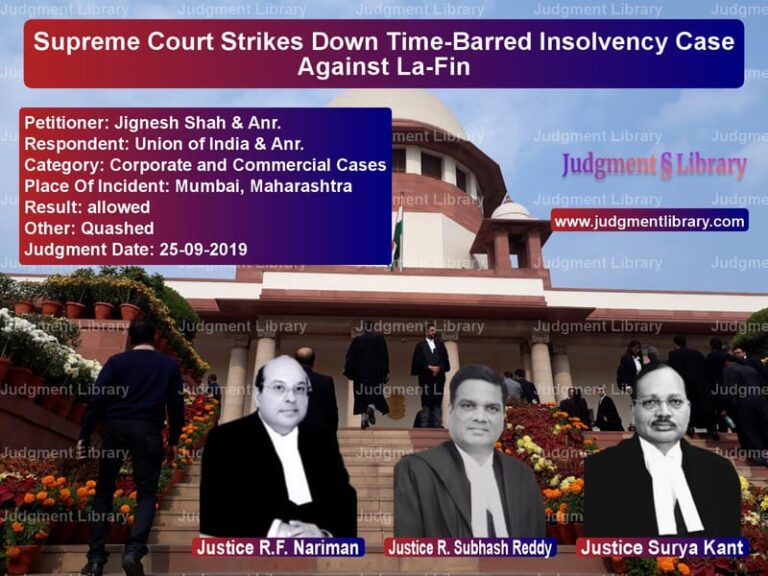Supreme Court Acquits Man in Wife’s Murder Case Due to Lack of Evidence
The Supreme Court of India recently ruled on the case of Ravi v. The State of Punjab, overturning a conviction in a case of alleged murder due to insufficient evidence. This case highlights the importance of circumstantial evidence in criminal trials and the necessity for the prosecution to establish guilt beyond a reasonable doubt.
Background of the Case
The case revolved around the death of Jamni, the wife of the appellant, Ravi. Ravi was accused of murdering his first wife by strangulation on the night of August 22, 2014. The prosecution alleged that he, along with his second wife Soma, was responsible for the crime.
The prosecution’s case was based on a complaint filed by Chaina Ram (PW-1), the deceased’s brother, who initially claimed that Ravi killed his sister. However, in court, he later changed his statement and said that his sister died of illness. Similarly, Rajo (PW-2), the deceased’s sister, also retracted her statement, stating that there was no dispute between Ravi and his wife, and she had died naturally due to illness. This retraction of key witnesses played a crucial role in the case.
Prosecution’s Claims
The prosecution relied on the following circumstantial evidence:
- The brother (PW-1) had filed an FIR stating that Ravi strangled his wife with the help of his second wife, Soma.
- The deceased’s sister (PW-2) initially claimed she had seen Ravi committing the crime.
- The post-mortem report indicated death due to asphyxia from strangulation.
- The appellant allegedly carried his wife’s dead body to her native place in a truck.
- A rope was recovered from the accused, which was claimed to be the murder weapon.
Defense’s Claims
The defense challenged the prosecution’s claims on the following grounds:
- All key witnesses, including PW-1 (brother), PW-2 (sister), and PW-3 (cousin), turned hostile in court.
- The post-mortem report suggested that the ligature marks on the deceased’s neck could have resulted from tuberculosis or the long journey of the dead body in a truck.
- The rope recovered as evidence was a common household item available in the market, making it impossible to link it conclusively to the crime.
- There was no direct evidence or eye witness testimony confirming the murder.
- The accused stated in his statement under Section 313 CrPC that his wife died due to a prolonged illness (chronic tuberculosis) and was under treatment.
Supreme Court’s Observations and Judgment
The Supreme Court ruled in favor of Ravi, citing lack of conclusive evidence.
Key observations by the Court:
- “The circumstances from which the conclusion of guilt is to be drawn should be fully established.”
- “There must be a chain of evidence so complete as not to leave any reasonable ground for the conclusion consistent with the innocence of the accused.”
- “The prosecution has failed to prove beyond a reasonable doubt that the accused committed the crime.”
- “Section 106 of the Evidence Act cannot be applied unless the prosecution first discharges its burden of proof.”
- “The post-mortem report does not conclusively establish that the cause of death was murder.”
Final Judgment
The Supreme Court overturned the Punjab and Haryana High Court’s conviction and ordered Ravi’s immediate release. The Court emphasized that:
- The prosecution’s case was based on circumstantial evidence that did not meet the legal standards of proof.
- The testimony of key witnesses turning hostile created serious doubts about the veracity of the charges.
- The medical evidence was inconclusive and failed to rule out natural causes of death.
- The recovered rope could not be definitively linked to the crime.
Impact of the Judgment
This ruling reinforces the principle that an accused person cannot be convicted based on weak circumstantial evidence. The judgment is significant because:
- It reiterates the importance of proving guilt beyond a reasonable doubt in criminal trials.
- It prevents wrongful convictions based on unreliable witness testimonies.
- It underscores the need for robust forensic evidence in cases relying on circumstantial evidence.
- It clarifies the correct application of Section 106 of the Evidence Act.
The judgment is expected to influence future cases where the prosecution relies on circumstantial evidence, ensuring that only strong, conclusive proof is used to establish guilt.
Petitioner Name: Ravi.Respondent Name: The State of Punjab.Judgment By: Justice Pankaj Mithal, Justice Ahsanuddin Amanullah.Place Of Incident: Amritsar, Punjab.Judgment Date: 10-02-2025.
Don’t miss out on the full details! Download the complete judgment in PDF format below and gain valuable insights instantly!
Download Judgment: ravi-vs-the-state-of-punjab-supreme-court-of-india-judgment-dated-10-02-2025.pdf
Directly Download Judgment: Directly download this Judgment
See all petitions in Murder Cases
See all petitions in Bail and Anticipatory Bail
See all petitions in Judgment by Pankaj Mithal
See all petitions in Judgment by Ahsanuddin Amanullah
See all petitions in allowed
See all petitions in supreme court of India judgments February 2025
See all petitions in 2025 judgments
See all posts in Criminal Cases Category
See all allowed petitions in Criminal Cases Category
See all Dismissed petitions in Criminal Cases Category
See all partially allowed petitions in Criminal Cases Category







